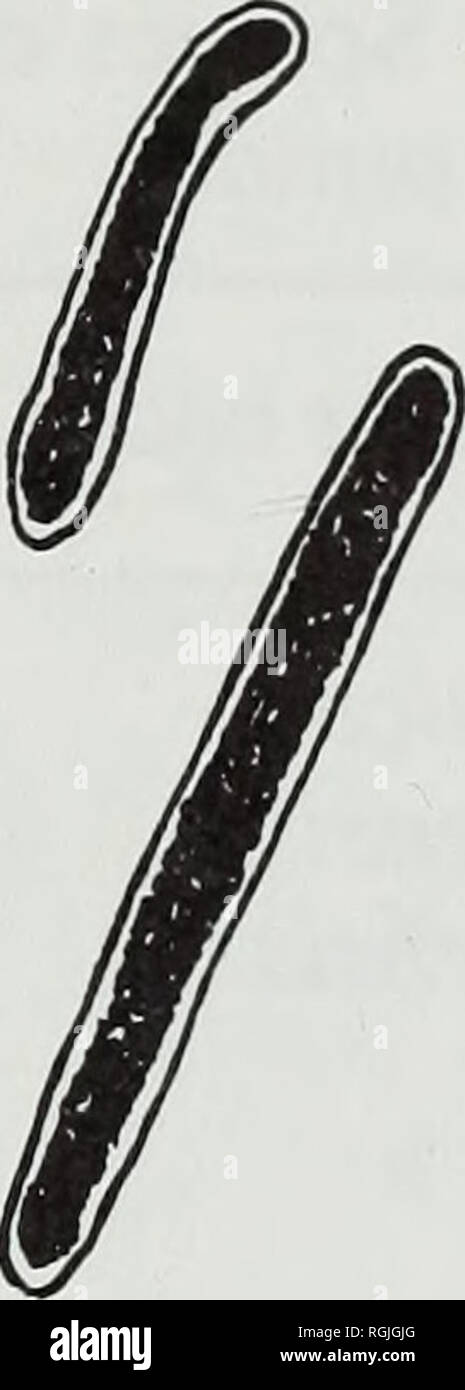. Bulletin of the British Museum (Natural History). Botany; Botany. Fig. 1 Conidia in genus Parmelia s. lat. a: conidiophore with filiform conidia, P. euneta Stirton, 3K 16/122. b: bifusiform conidium, P. ducalis Jatta, E 30/12. c: sublageniform conidium, P. maclayana Miill. Arg., Ryvarden 9032. d: unciform conidium, P. subpraesignis Nyl., T 16/137. e: rod-shaped conidium, P. eciliata (Nyl.) Nyl., 4 May 1978, Dahls.n. Sublageniform conidia with one or two darker 'dots' (see below under rod-shaped conidia) have been seen in the subgenus Everniiformes. (c) Unciform conidia. We have chosen this t

Image details
Contributor:
Book Worm / Alamy Stock PhotoImage ID:
RGJGJGFile size:
7.2 MB (144.4 KB Compressed download)Releases:
Model - no | Property - noDo I need a release?Dimensions:
946 x 2642 px | 8 x 22.4 cm | 3.2 x 8.8 inches | 300dpiMore information:
This image is a public domain image, which means either that copyright has expired in the image or the copyright holder has waived their copyright. Alamy charges you a fee for access to the high resolution copy of the image.
This image could have imperfections as it’s either historical or reportage.
. Bulletin of the British Museum (Natural History). Botany; Botany. Fig. 1 Conidia in genus Parmelia s. lat. a: conidiophore with filiform conidia, P. euneta Stirton, 3K 16/122. b: bifusiform conidium, P. ducalis Jatta, E 30/12. c: sublageniform conidium, P. maclayana Miill. Arg., Ryvarden 9032. d: unciform conidium, P. subpraesignis Nyl., T 16/137. e: rod-shaped conidium, P. eciliata (Nyl.) Nyl., 4 May 1978, Dahls.n. Sublageniform conidia with one or two darker 'dots' (see below under rod-shaped conidia) have been seen in the subgenus Everniiformes. (c) Unciform conidia. We have chosen this term to denote rod-shaped conidia c. 5 /im long, with a single hook-shaped end (Fig. Id), a type not discussed by Gluck (1899) or Vobis (1980). They are particularly characteristic for Parmelia subgenus Parmelia sect. Simplices. occurring in all the species examined by us, with the exception of P. microsticta Miill. Arg. and P. hypoleucites Nyl 5. str. in which they were filiform (see also W. Culberson & C. Culberson, 1980). The presence of unciform conidia in Amphigymnia has not been con- clusively proved. (d) Rod-shaped (bacilliform) conidia. This is a rather heterogeneous group, consisting of rods mainly 8-10(12) jum long and about 10-12 times as long as broad (Fig. le). They have no swellings, but in some cases one or two darker 'dots' are situated in either a central, subapical, or apical position. We have made no effort to distinguish between the various types of'dotted rods' in this work. They are of little interest in Amphigymnia but occur in the subgenus Cyclocheila and subgenus Parmelia sections Parmelia and Bicornuta. Plain (i.e. non-'dotted') rods, on the other hand, occur in a few Amphigymnia species, such as Parmelia eciliata and P. mesotropa. They form a transition between weakly sublageniform and filiform conidia. (e) Filiform conidia. Filamentous conidia have been described as filiform by, for example, Vainio (1890), Moberg (1977), and Vobis (1980). Their di